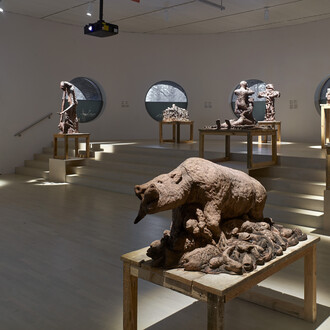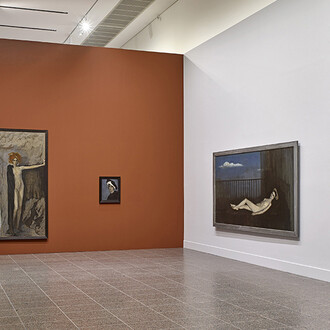Achim Duchow (1948–1993), Christof Kohlhöfer (b. 1942, lives in Los Angeles), Memphis Schulze (1944–2008): three artists whose paths were closely linked in the 1970s and who lived during the period of late Pop Art between a social-critical spirit, humorous commentary, and free and visionary artistic worlds. It was a period of many collaborations, resulting in numerous joint works with Sigmar Polke. This dense and still not entirely investigated period of the 1970s is currently under exploration at the exhibition Singular. Plural. Kollaborationen in der Post-Pop-Politik-Arena at Kunsthalle Düsseldorf (on view until October 1, 2017). The exhibition Broadway the Hard Way at Setareh Gallery takes a look ahead and focuses on the 1980s.
The stylistically varied work of Achim Duchow stands out with its critical, acerbic, humorous gaze on current events, social norms, and the values of the period. He used intelligently chosen visual strategies like quotation and adaptation to radically question and comment incisively on both society and art. On numerous journeys and during his three-year stay in Japan (1978–81), Duchow proved himself to be a cosmopolitan who knew how to detect the strange and familiar aspects of a culture in his own work. Achim Duchow’s works, which are characterized by a fine sense of the period and irony, lack nothing of their topicality today.
Fascinated by American postwar culture, Christof Kohlhöfer’s work draws graphic visual elements from the world of comics, superimposes them with political symbols, and creates new visual contexts. With stencils and spray paint that he discovered from stationed American GIs, he introduced this aesthetic to fine art. After an exhibition at Cologne’s Galerie Oppenheim in 1976, Kohlhöfer took a chance: he has himself paid in cash by his gallerist, threw the key to his studio into the Rhine, and was on the next plane to New York. There, he joined the American art world. His collage-like paintings seem in part almost caricature-like and comment intuitively with humor. In his works, the artist showed his proximity to pop art as an equally subversive and creative mind. The results are complex visual worlds between banality and opulence, subculture and high art.
At the end of the 1960s, Memphis Schulze began implementing a concept of art informed by pop art, Picabia, and the rebellious spirit of the time in a varied, irreverent, and still fresh oeuvre. Born as Jürgen Max Schulze, he based his artist name on Chuck Berry’s legendary song Memphis, Tennessee. Thanks to his painted record covers, Polke became aware of him and invited him to an exhibition in Kiel. In Memphis Schulze’s multilayered works, we can find the insignia of his era: popular culture, music, and a revolutionary attitude. Figures from underground comics encounter ancient mythological heroes, sexy ladies are placed next to romantic figures, realistic figuration meets strict abstraction. The elements stand on their own, but also combine to form a cosmos of their own and open new visual worlds and layers for the beholder.
















